Solar-Powered Desalination Technologies for Sustainable Water Security Solutions
Abstract
The increasing global demand for freshwater, coupled with the depletion of conventional water sources, has made desalination an important area of research. Solar-powered desalination presents a sustainable alternative by harnessing renewable energy to reduce carbon emissions and operational costs. This paper examines key solar desalination technologies, including solar thermal, photovoltaic (PV)-driven reverse osmosis (RO), and solar stills, assessing their efficiency, scalability, and environmental impact. It explores their role in addressing water scarcity, evaluates their economic viability, and compares their environmental impact with conventional desalination methods. Additionally, the review offers recommendations for advancing solar desalination through policy support, technological innovation, and market development. While these methods offer promising solutions, widespread adoption is hindered by high capital costs, energy intermittency, and technological limitations. However, innovations in hybrid renewable energy systems, energy storage, and advanced desalination membranes present opportunities for improvement. Future research should focus on enhancing system efficiency, reducing costs, and integrating solar desalination with agricultural and industrial applications. Supportive policies and financial incentives are important to facilitate large-scale implementation, particularly in water-stressed and off-grid regions. By contributing to global water security (United Nations [UN] Sustainable Development Goal [SDG] 6) and clean energy goals (SDG 7), solar desalination holds significant potential for a more sustainable and resilient future.
1. Introduction
Water scarcity has become an increasingly pressing global challenge (Figure 1), exacerbated by factors such as population growth, urbanization, industrialization, and climate change. Water is an essential resource for survival and is projected to become a contentious resource in the future decades [2, 3]. Access to safe and reliable freshwater is essential for human health, food production, industrial activities, and ecosystem functioning. However, the availability of freshwater resources is finite, and many regions around the world are facing water stress or outright scarcity [4, 5]. According to the United Nations (UN), over 2 billion people live in countries experiencing high water stress, and this number is expected to rise as demand for water continues to increase while freshwater supplies dwindle. Additionally, ~4 billion people already experience severe water scarcity during at least 1 month of the year [6–8]. In 2020, worldwide water stress was tolerable at 18.2%, but 2.4 billion people lived in places prone to extreme stress. Despite improvements, billions of people still lack access to clean drinking water, sanitation, and hygiene. Achieving universal coverage by 2030 necessitates significant development in these areas. Water use efficiency has increased by 9%, yet water stress and scarcity remain major issues exacerbated by conflicts and climate change [1, 7]. Traditional freshwater sources, such as rivers, lakes, and groundwater aquifers, are being depleted at unsustainable rates, leading to environmental degradation and social conflicts over water resources [9, 10]. Furthermore, contamination of freshwater sources by pollutants from agricultural runoff, industrial discharge, and untreated sewage further diminishes the available supply of safe drinking water [11, 12].
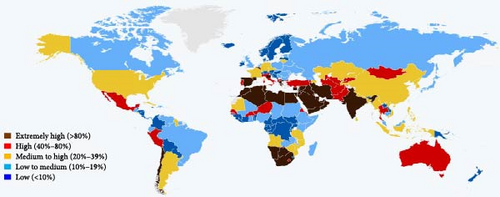
In this context, addressing water scarcity requires innovative and sustainable solutions that can augment existing water supplies, improve water quality, and enhance water resource management practices. One such solution is the utilization of solar energy for water desalination to mitigate this pressing challenge of escalating water scarcity globally [13–16]. Solar energy, abundant and freely available in most regions of the world, offers a promising avenue for sustainable water desalination (Figure 2). By harnessing the power of the sun, desalination processes can convert seawater, brackish water, or even wastewater into fresh, potable water suitable for various applications. Unlike conventional desalination methods reliant on fossil fuels, solar-powered desalination systems minimize carbon emissions and environmental impact, making them environmentally friendly alternatives by reducing reliance on finite fossil fuel resources and also mitigating greenhouse gas emissions associated with traditional energy-intensive desalination methods [18–20].
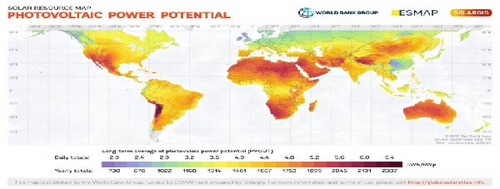
Furthermore, solar energy’s ubiquity ensures accessibility in remote or off-grid areas where conventional infrastructure may be lacking. Thus, integrating solar energy into water desalination not only enhances water security but also promotes sustainability and resilience in the face of climate change and resource constraints [21]. Nevertheless, the growing market for solar desalination technologies presents economic opportunities for innovation, investment, and job creation. As solar energy technologies become more efficient and cost-effective, the deployment of solar-powered desalination plants becomes increasingly viable, especially in regions with abundant sunlight and high water stress [22–24]. Consequently, the integration of solar energy into water desalination not only represents an important step toward achieving water security but also embodies a paradigm shift toward sustainable development, offering a pathway to meet the water needs of current and future generations while safeguarding the planet’s finite resources.
Thus, this paper examines the potential of solar energy as a sustainable solution for desalination, focusing on key technologies that apply solar power for water purification. Specifically, we evaluate the operational principles, efficiency, cost-effectiveness, and feasibility of various solar desalination methods, including solar stills, reverse osmosis (RO), electrodialysis (ED), multieffect distillation (MED), and multistage flash (MSF) distillation. By comparing these technologies, we provide insights into their advantages, limitations, and potential for large-scale deployment in addressing global water security challenges. By reviewing existing literature and research findings on the intersection of solar energy and water desalination, this study will contribute to the ongoing discourse on sustainable water management practices that benefit communities, economies, and ecosystems worldwide and provide understandings into innovative solutions for ensuring equitable access to clean water resources.
2. Overview of Water Desalination
Desalination, fundamentally, is the process of removing salts and other impurities from water, making it suitable for various purposes such as drinking, irrigation, and industrial use [25, 26]. As freshwater sources become increasingly scarce or contaminated, desalination plays a crucial role in augmenting water supplies and ensuring access to clean water for human consumption and other vital needs [27, 28]. The primary objective of desalination is to produce freshwater from saline or brackish water sources (which has a lower salt content than seawater but is still unsuitable for consumption), thereby addressing water scarcity issues and ensuring a reliable supply of potable water [29, 30]. This process is especially critical in regions where traditional freshwater sources, such as rivers, lakes, and groundwater aquifers, are either insufficient or contaminated due to factors like industrial pollution, agricultural runoff, and saline intrusion. The significance of desalination becomes particularly important in areas characterized by arid or semiarid climates, where water scarcity is a chronic challenge [31, 32]. Coastal regions, in particular, benefit from desalination technologies due to their proximity to abundant seawater resources. By harnessing desalination, these regions can tap into a virtually unlimited source of water, thereby reducing their dependence on rainfall-dependent freshwater supplies. Moreover, desalination plays an important role in enhancing water resilience in the face of climate change-induced impacts such as prolonged droughts, erratic precipitation patterns, and rising sea levels [33, 34]. As climate-related water stress intensifies, desalination provides a buffer against water shortages, ensuring continuity in water supply for domestic, industrial, and agricultural needs. Beyond its immediate role in addressing water scarcity, desalination contributes to broader socioeconomic development goals. Access to clean and reliable freshwater is essential for public health, sanitation, and hygiene, thereby reducing the prevalence of waterborne diseases and improving overall well-being [35, 36]. Furthermore, desalination supports agricultural productivity by providing irrigation water for crops, thus bolstering food security in water-stressed regions [37, 38]. However, it is essential to recognize that desalination is not without its challenges. The process requires significant energy inputs, typically in the form of electricity or thermal energy, which can be costly and environmentally impactful if derived from fossil fuels [39, 40]. Additionally, desalination plants produce brine as a byproduct, which must be carefully managed to prevent ecological harm to marine ecosystems [26, 41]. Despite these challenges, advancements in desalination technologies, coupled with the increasing availability of renewable energy sources such as solar and wind power, offer opportunities to enhance the sustainability and affordability of desalination processes [13, 14]. By integrating renewable energy sources, such as solar energy, into desalination systems, it becomes possible to reduce greenhouse gas emissions, lower operating costs, and improve the overall environmental footprint of desalination operations.
2.1. Traditional Desalination Methods
Traditional desalination methods have been employed for centuries to address water scarcity by removing salts and other impurities from saline or brackish water sources [27, 42, 43]. These methods, while effective to a certain extent, come with inherent limitations that impact their efficiency, cost-effectiveness, and environmental sustainability. One of the oldest and most widely used traditional desalination methods is distillation. Distillation involves heating saline water to produce steam, which is then condensed to yield freshwater. While distillation is relatively simple and can be implemented using basic equipment, it is energy-intensive and requires significant amounts of heat to operate efficiently [44, 45]. Additionally, distillation plants are typically large-scale facilities, making them costly to construct and maintain. Another traditional desalination method is RO, which utilizes semipermeable membranes to separate salt ions from water molecules under pressure. While RO is more energy-efficient than distillation, it still requires electricity to power the pumps and membranes, contributing to operational costs. Moreover, RO membranes are prone to fouling and degradation over time, necessitating regular maintenance and replacement [46–49]. Other traditional desalination methods include ED, which relies on ion-selective membranes and an electric field to separate ions from water, and freezing desalination, which involves freezing saline water and then separating the ice crystals from the remaining liquid [49–51].
However, these methods have their own set of limitations, including high energy consumption. Overall, traditional desalination methods face several challenges that limit their widespread adoption and effectiveness in addressing water scarcity. These challenges include high energy requirements, operational costs, environmental impacts (such as greenhouse gas emissions and brine disposal), and limited freshwater production capacity [52, 53].
In recent years, there has been growing interest in developing and deploying more innovative and sustainable desalination technologies to overcome these limitations. These technologies include solar-powered desalination, membrane distillation, forward osmosis, and capacitive deionization, among others. By harnessing renewable energy sources, improving membrane materials and processes, and optimizing system designs, these innovative desalination technologies offer the potential to enhance water security, reduce environmental impact, and lower costs compared to traditional methods.
2.2. Solar Energy Technologies for Desalination
Solar desalination technologies vary in efficiency, scalability, and economic feasibility. The most widely used methods include solar stills, solar-powered RO, ED, MED, and MSF distillation. In recent years, solar-powered desalination has emerged as a promising and sustainable alternative to traditional desalination methods, offering a solution to address water scarcity challenges while minimizing environmental impact. Unlike conventional desalination methods that rely on fossil fuels or grid electricity, solar-powered desalination harnesses the abundant and renewable energy of the sun to drive the desalination process [54–56]. Solar distillation units use sun energy to evaporate salty water, which is collected as freshwater in a condensate trough. The water vapor condenses on a transparent glass or plastic covering, transmitting radiant energy and allowing water vapor to condense (Figure 3). Proper disposal is necessary for the brine solution formed in the still basin, which contains salt and un-evaporated water [58].
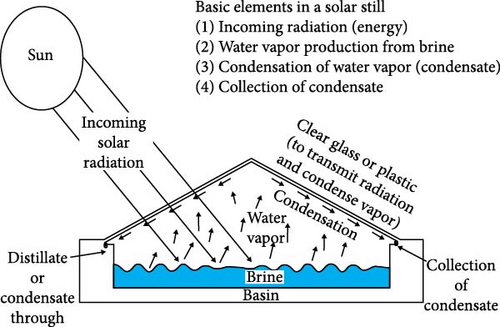
There are several ways in which solar energy can be integrated into desalination processes, including photovoltaic (PV) systems, concentrated solar power (CSP) systems, and hybrid solar desalination systems.
3. Desalination Processes Utilizing Solar Energy
Solar desalination technologies are categorized into two main approaches: direct and indirect methods. Desalination techniques encompass a variety of processes aimed at removing salts and other impurities from water to produce freshwater suitable for various applications (Figure 4). These techniques can be broadly categorized into thermal and membrane-based processes. Thermal desalination methods involve heating saline water to produce steam, which is then condensed to yield freshwater, while membrane-based processes rely on semipermeable membranes to separate salt ions from water molecules [60, 61]. One of the most straightforward and widely used techniques for direct solar desalination is the solar still. Solar stills are simple devices that use solar energy to desalinate water through evaporation and condensation, mimicking the natural water cycle [62, 63]. These systems can be categorized into passive and active stills, with various basin designs influencing performance. Single-basin passive solar stills typically produce 2–5 L/m2/day, but modifications can enhance efficiency. Factors affecting performance include water depth, insulation, basin liner absorptivity, and reflectors. Cylindrical basin shapes and copper materials have shown superior performance [64, 65]. Recent advancements incorporate phase change materials, nanotechnology, and hybrid systems to improve productivity [63]. Another prominent method is solar membrane distillation, which utilizes hydrophobic membranes to separate water vapor from saline solutions [66]. It can be effectively coupled with solar energy due to its low operating temperatures. Two main variations exist: direct contact membrane distillation and air gap membrane distillation, each with unique advantages [67]. A novel solar-driven air gap system has been developed, demonstrating nearly twice the thermal efficiency of conventional solar-powered membrane distillation systems [68]. Despite its potential, challenges remain, including limited production and energy performance compared to commercial-scale desalination.
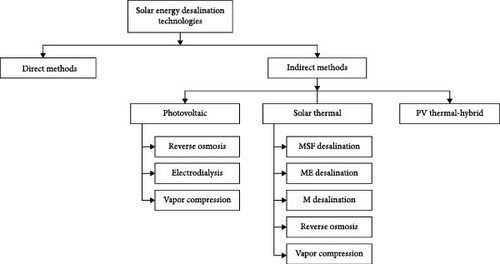
3.1. PV Systems
PV systems harness sunlight directly to generate electricity through the PV effect. This effect occurs when photons from sunlight strike the semiconductor material within PV cells, causing electrons to be released and creating an electric current. This electricity can then be used to power various electrical devices, including desalination equipment [69–71]. PV systems are well-suited for powering desalination processes, particularly those that require electricity, such as solar energy RO and ED. In RO desalination, for example, PV-generated electricity can be used to drive pumps that pressurize seawater and force it through semipermeable membranes to remove salt ions [72, 73]. Similarly, in ED, PV electricity can facilitate the separation of ions from water using ion-selective membranes and an electric field. PV desalination systems offer flexibility and scalability, making them suitable for a wide range of applications and locations [74, 75].
PV systems offer several advantages for desalination applications. They are modular and can be easily integrated into existing desalination plants or deployed in remote areas with limited infrastructure. Additionally, PV systems have minimal environmental impact and produce no greenhouse gas emissions during operation, making them environmentally friendly alternatives to fossil fuel-based electricity generation [76, 77]. However, PV systems also have limitations that must be considered. One limitation is their dependence on sunlight, which can vary depending on factors such as time of day, weather conditions, and geographic location. As a result, PV systems may require energy storage solutions, such as batteries, to ensure continuous operation during periods of low sunlight. Additionally, the upfront capital costs of PV systems can be significant, although ongoing advancements in PV technology and economies of scale are driving down costs over time [78, 79].
3.1.1. RO Desalination

RO desalination can be integrated with solar energy systems to reduce reliance on grid electricity and fossil fuels, making the process more sustainable and environmentally friendly. Solar energy can be used to power the pumps, motors, and other electrical components of the RO system, either directly through PV panels or indirectly through grid-connected solar power systems. In standalone solar-powered RO systems, PV panels generate electricity to power the RO process, while excess energy can be stored in batteries for use during periods of low sunlight or high energy demand. In grid-connected systems, solar energy supplements grid electricity, reducing overall energy consumption and operating costs. Additionally, solar thermal energy can be utilized to preheat the feedwater before entering the RO membrane, thereby reducing the energy required for membrane pressurization and increasing overall system efficiency.
3.1.2. ED
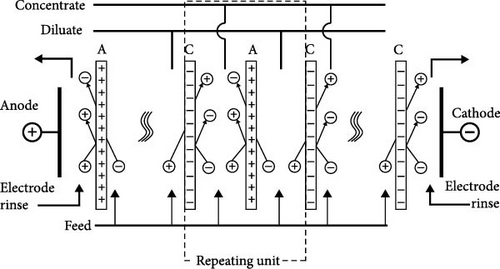
The feasibility of solar integration in ED depends on various factors, including the energy requirements of the ED process, the availability of solar resources, and solar technologies. While ED itself does not directly utilize heat or electricity for desalination, solar energy can be integrated into ED systems to provide the electricity needed to power pumps, control systems, and other auxiliary equipment. Solar PV panels can be used to generate electricity for powering ED systems, either in standalone configurations or in grid-connected systems. PV systems can be designed to match the energy demand of the ED process, ensuring reliable and sustainable operation. Additionally, excess solar energy can be stored in batteries or used for other applications, further enhancing energy efficiency and system resilience.
Generally, the integration of solar energy reduces operating costs, enhances environmental sustainability, and promotes energy independence, reinforcing resilience in water supply infrastructure and contributing to global water security. However, successful implementation hinges on careful consideration of site-specific factors, technology, regulatory frameworks, and economic viability, emphasizing the importance of ongoing research, innovation, and collaboration in realizing the full potential of solar-powered desalination.
3.2. CSP Systems
CSP systems concentrate sunlight using mirrors or lenses onto a small area, typically a receiver or solar collector (Figure 7). The concentrated sunlight heats a working fluid, such as molten salt or synthetic oil, to high temperatures. This thermal energy is then used to generate steam, drive turbines, and produce electricity through a conventional steam turbine generator or other thermal processes, which is then used to drive the desalination process, typically through distillation or evaporation [86–88]. A distinctive feature of CSP lies in its ability to store the generated heat, enabling continuous operation, even in the absence of sunlight, during early morning or late evening hours.
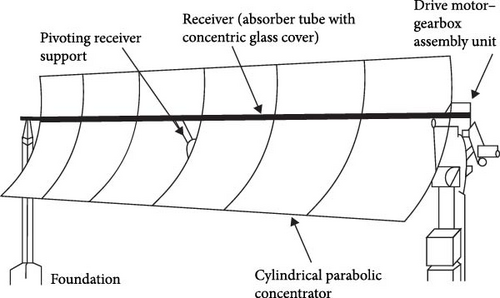
CSP systems can be integrated with desalination processes in several ways. One approach is to use the thermal energy generated by CSP systems to directly power thermal desalination processes such as MSF distillation or MED. In these processes, the high-temperature steam produced by CSP systems is used to evaporate seawater and separate freshwater from salt [89–93]. Another approach is to use the electricity generated by CSP systems to power electrical desalination processes such as RO or ED. In this case, CSP-generated electricity can be used to drive pumps, membranes, and other electrical components of the desalination plant [49, 50, 81, 82].
CSP systems offer several advantages for desalination applications. They provide a reliable and dispatchable source of renewable energy, as thermal energy storage systems can store excess heat generated during the day for use at night or during periods of low sunlight. Additionally, CSP systems can achieve high temperatures and thermal efficiencies, making them well-suited for thermal desalination processes that require high-temperature steam. Moreover, CSP systems can be deployed in conjunction with desalination plants, providing both electricity and thermal energy to power various desalination processes [94–96]. However, CSP systems also have limitations that must be considered. One limitation is their relatively high upfront capital costs compared to other solar technologies, such as PV systems. CSP systems also require large land areas for the installation of solar collectors and infrastructure, which may be challenging in densely populated or land-constrained areas. Additionally, CSP systems are sensitive to weather conditions and require clear skies and direct sunlight to operate efficiently, which may limit their applicability in certain regions with frequent cloud cover or low solar irradiance.
3.2.1. MSF Distillation
Solar thermal MSF distillation is a thermal desalination process that utilizes the principle of evaporation and condensation to separate freshwater from saline water. In MSF distillation (Figure 8), seawater is heated to high temperatures under reduced pressure, causing it to flash evaporate into vapor. The vapor then condenses on a series of heat exchanger tubes or trays at lower temperatures, producing freshwater. The process consists of multiple stages, each comprising a flash chamber where the seawater is flashed and a condenser where the vapor is condensed. The vapor condenses into freshwater, while the remaining concentrated brine is discharged from the system [89–91, 98, 99].
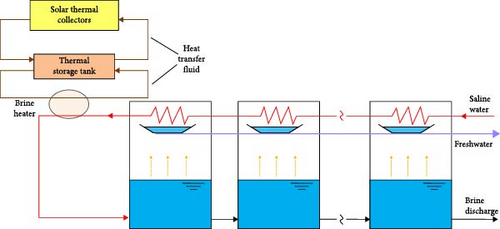
In MSF distillation, heat is supplied to the seawater to increase its temperature and facilitate evaporation. The heat input Q is equal to the mass flow rate m of seawater multiplied by the difference in enthalpy between the inlet seawater hin and the outlet brine hout. This heat input causes the seawater to flash evaporate into vapor, which then condenses to produce freshwater.
MSF distillation has the potential to be integrated with solar energy systems to reduce energy consumption and operating costs. Solar thermal energy can be used to heat the seawater and provide the necessary energy for evaporation. Solar collectors, such as parabolic troughs or flat-plate collectors, can capture sunlight and transfer it to a heat transfer fluid, which is then used to heat the seawater in the MSF distillation system [100–102]. The integration of solar energy can significantly reduce the reliance on fossil fuels or grid electricity, making MSF distillation more sustainable and environmentally friendly.
3.2.2. MED
MED is a thermal desalination process that utilizes multiple stages of evaporation and condensation to produce freshwater from saline water. In MED (Figure 9), seawater is heated to generate steam, which is then passed through a series of evaporator stages, each operating at progressively lower pressures. As the steam passes through each stage, it heats the feedwater in the adjacent stage, causing it to evaporate and produce freshwater vapor. The vapor is then condensed on heat exchanger surfaces, where it transfers its latent heat to the incoming feedwater, thereby preheating it. This preheated feedwater subsequently enters the next stage, where it is further heated and evaporated. The process continues through multiple stages, with each subsequent stage operating at lower temperatures and pressures, resulting in higher energy efficiency and freshwater production [92, 93, 103, 104]. MED is highly suitable for integration with solar energy systems due to its thermal nature and low operating temperatures. Solar thermal energy can be used to provide the heat input required for evaporation, thereby reducing the dependency on conventional energy sources such as fossil fuels or grid electricity.
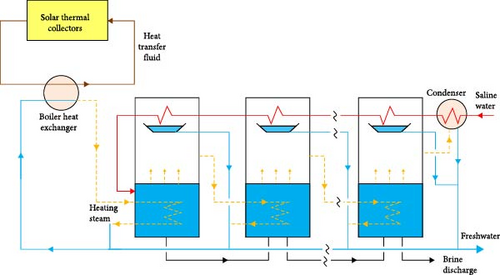
3.3. Hybrid Solar Desalination Systems
Hybrid solar desalination systems combine the strengths of PV and CSP technologies (Figure 10) to create integrated and efficient solutions for water desalination. These systems leverage the complementary nature of PV and CSP technologies to optimize energy capture, storage, and utilization throughout the day and under varying weather conditions [94, 95].

One of the key synergies of hybrid solar desalination systems is their ability to maximize energy production and utilization. PV systems excel in generating electricity during daylight hours, while CSP systems can provide both electricity and thermal energy, including during periods of low sunlight or at night through thermal energy storage. By integrating PV and CSP technologies, hybrid systems can achieve a continuous and reliable energy supply, ensuring uninterrupted operation of desalination processes [106–108]. Furthermore, hybrid solar desalination systems offer flexibility and resilience in energy management. Excess electricity generated by PV systems during peak sunlight hours can be used to charge thermal energy storage systems or power auxiliary equipment, optimizing energy usage and reducing reliance on the grid [94, 109, 110]. Conversely, CSP systems can provide supplementary thermal energy to meet desalination process requirements, especially during periods of high energy demand or low solar irradiance.
Despite the numerous benefits, hybrid solar desalination systems also face several challenges. One challenge is the system design and integration, as combining PV and CSP technologies requires careful consideration of components, control systems, and operational strategies to maximize efficiency and performance. Additionally, hybrid systems may entail higher upfront capital costs compared to standalone PV or CSP systems, which could pose financial barriers to adoption, particularly in cost-sensitive markets.
3.3.1. Solar-Powered Membrane Desalination
Solar-powered membrane desalination integrates renewable energy with advanced technologies to address global water scarcity [111]. RO remains the most widely used method, but forward osmosis and ED offer advantages in specific applications [112]. Recent advancements include hybrid systems, such as combining forward osmosis with membrane distillation, which can reduce energy consumption ratios from 0.89 to 0.64 [113]. PV-powered RO systems and solar thermal collectors coupled with membrane distillation show promise for sustainable desalination [112]. Innovations in nanotechnology and phase change materials have improved efficiency and thermal storage capabilities. Solar desalination can reduce the carbon footprint of water production by up to 70%, aligning with the UN Sustainable Development Goals (SDGs) [114]. While solar-powered desalination systems face challenges like initial capital costs and brine disposal, their ability to align with sustainability goals and reduce reliance on fossil fuels makes them a promising solution to address global water scarcity.
Generally, solar-powered desalination offers several key advantages over conventional desalination methods. First, it relies on a renewable energy source that is abundant and freely available in most regions of the world, reducing dependency [54, 55] on finite fossil fuels and mitigating greenhouse gas emissions. Second, solar desalination systems can be deployed in remote or off-grid areas where access to conventional energy infrastructure may be limited, providing a decentralized and sustainable solution to water scarcity. Furthermore, solar-powered desalination has the potential to lower operating costs and improve economic viability, particularly in regions with ample sunlight [54, 55]. While upfront investment costs may be higher than traditional desalination methods, the long-term benefits of reduced energy consumption and lower environmental impact can outweigh these initial expenses.
4. Performance Evaluation of Solar Desalination
4.1. Performance Analysis
These equations, along with considerations of system reliability, environmental impact, and social benefits, provide a comprehensive framework for evaluating the performance of solar desalination systems.
Table 1 provides highlights achieved in recent studies to enhance the efficiency, productivity, and improvement method of solar desalination systems.
| Study reference | Efficiency/productivity | Improvement method |
|---|---|---|
| Kaviti et al. [123] | Enhanced thermal performance through nanomaterials | Incorporation of cerium oxide (CeO2) and MWCNTs to improve thermal properties |
| Abdel-Rehim and Lasheen [124] | 5%–6% increase in efficiency during peak months | Packed layer thermal energy storage to enhance system efficiency |
| Wiener et al. [125] | Significant performance improvements through evaporation | Fabric-coated polyurethane rollers with capillary action to increase evaporation area |
| Narayanan et al. [126] | Varies by system; focuses on key performance factors | Review factors like solar radiation intensity and ambient temperature affecting solar still performance |
| Shoeibi et al. [127] | Improved thermal efficiency through heat pipes | Integration of heat pipes and pulsating heat pipes to enhance heat transfer |
For instance, Kaviti et al. [123] demonstrated how integrating nanomaterials like cerium oxide (CeO2) and multiwalled carbon nanotubes (MWCNTs) can significantly enhance thermal performance while reducing operational and maintenance costs. Similarly, Abdel-Rehim and Lasheen [124] showed a 5%–6% increase in efficiency during peak months through the incorporation of packed layer thermal energy storage, emphasizing the role of optimized thermal management. Innovative designs were explored by Wiener et al. [125], who achieved notable performance improvements using fabric-coated polyurethane rollers, which leveraged capillary action to expand the evaporation surface area. Meanwhile, Narayanan et al. [126] provided a comprehensive review of performance factors, such as solar radiation intensity and ambient temperature, to identify critical areas influencing system efficiency. Lastly, Shoeibi et al. [127] advanced the integration of heat pipes and pulsating heat pipes, significantly improving thermal energy transfer within solar desalination systems.
4.2. Comparative Analysis of Different Technologies
In the performance evaluation for solar desalination, a comparative analysis of the different technologies and configurations plays an important role [128, 129]. This assessment encompasses several key factors, such as energy efficiency, WPC, system reliability, and environmental impact. By scrutinizing these aspects, stakeholders can discern the most suitable technology for a given application [47, 113, 130, 131]. Factors such as energy consumption per unit of freshwater produced, total cost of water production, system uptime, maintenance requirements, and environmental footprint should be evaluated. Additionally, considerations regarding scalability, flexibility, and adaptability to varying water demand are integral to the comparative analysis [77, 131]. Ultimately, this comprehensive assessment aids in making informed decisions regarding technology selection, system design, and implementation strategies, ensuring the optimal balance between energy efficiency, cost-effectiveness, reliability, and environmental sustainability in addressing water scarcity challenges. Table 2 presents a comparative analysis of various solar desalination technologies, highlighting their key features, energy consumption, water production capacity, cost, and environmental impact. Solar stills offer a simple and sustainable method with low emissions, while solar-powered RO systems provide efficient desalination for remote areas, albeit with higher energy consumption.
| Technology | Energy consumption | Water production and cost | Environmental impact | Notable studies |
|---|---|---|---|---|
| Solar stills: sustainable, various designs (multislope, pyramid) | Varies by design | Higher water production in conventional pyramid stills | Lower CO2 emissions, high life cycle efficiency | Suraparaju et al. [132] |
| Solar-powered reverse osmosis (RO): desalinates brackish/seawater, off-grid potential | 40–200× ideal SEC; Brazil: 3.03 kWh/M3 | Cost: Brazil—$12.76/m3; Abu Dhabi—5 m3/h capacity | Up to 1850 m3/m2 seawater, 11,570 m3/m2 brackish water | Delgado-Torres and García-Rodríguez [133] |
| Electrodialysis: removes salts and captures CO2, potential emissions reduction | 123 Wh/M NaCl—0.070 kWh | Carbon footprint: 59.74 kg CO2-eq/metric ton salt removed | CO2 emissions reduction up to 92%, RED integration lowers SWRO emissions by 1.95 kg CO2-eq/m3 | Xue et al. [134] |
| Multieffect distillation: efficient with more effects, solar integration viable | Dependent on temperature and effects | Cost: 10 m3/day—$15/m3; 5000 m3/day—$1.25/m3 | High energy efficiency, sustainability improves at scale | Alhaj et al. [135] |
| Multistage flash distillation: energy-intensive, benefits from power plant integration | 13.5–25.5 kWh/M3; with power plant ~60 kWh/M3 | Cost: 0.69 $/m3 (optimized design) | CO2 reduction: 1167.5 tons/year, hybrid MSF-membrane system improves efficiency | Darwish and Al-Najem [136] |
- Abbreviations: RED, reverse electrodialysis; SWRO, seawater reverse osmosis.
This table highlights that ED shows promise for desalination and CO2 capture, reducing emissions significantly. MED improves efficiency with more effects and scales well economically, whereas MSF distillation, though energy-intensive, benefits from integration with power plants to enhance sustainability.
4.3. Challenges in Solar Desalination
In the journey of implementing solar desalination technologies, several challenges have emerged; one significant challenge is the upfront capital cost associated with deploying solar desalination systems, which can hinder widespread adoption, particularly in resource-constrained regions. Addressing this challenge requires innovative financing mechanisms, public–private partnerships, and cost-reduction strategies through technological advancements and economies of scale [19, 137, 138]. Additionally, the intermittent nature of solar energy presents operational challenges, requiring effective energy storage solutions and hybridization with other energy sources to ensure continuous water production [39, 139]. Moreover, site-specific factors such as solar irradiance, water quality, land availability, and regulatory constraints pose hurdles to the deployment of solar desalination projects, highlighting the importance of comprehensive feasibility studies and stakeholder engagement [138, 140, 141]. Thus, there is a need for holistic planning, interdisciplinary collaboration, adaptive management, and knowledge sharing to overcome barriers and unlock the full potential of solar desalination in addressing water scarcity sustainably.
5. Economic Viability and Environmental Impact
5.1. Cost Analysis of Solar Desalination Systems
Moreover, a comparative cost analysis of solar desalination technologies further highlights the differences in feasibility based on economic factors. Solar stills remain the most cost-effective option, but their scalability is limited. Solar-powered RO systems provide a practical balance between cost and efficiency, making them ideal for medium-scale applications. Meanwhile, MED and MSF systems, despite their high costs, are best suited for industrial and large-scale desalination projects. To improve cost efficiency, future research should focus on hybrid solar desalination systems that integrate multiple technologies to enhance performance while reducing the LCOW.
By conducting cost analysis, stakeholders can determine the LCOW production, compare it with alternative water supply options, and identify strategies to optimize cost-effectiveness and sustainability.
5.2. Factors Affecting Economic Feasibility of Solar Desalination
The factors affecting the economic feasibility of solar desalination systems encompass a range of variables, including technology selection, scale of operation, solar resource availability, energy efficiency, financing and investment options, regulatory environment, water demand and pricing, and lifecycle costs [122, 146, 147]. The choice of desalination technology influences capital costs and ongoing operational expenses, while the scale of the plant impacts economies of scale. Solar resource availability dictates the size and efficiency of solar energy systems, affecting overall costs [143]. Energy efficiency plays an important role in reducing electricity consumption and operating expenses [148, 149]. Access to favorable financing options and investment incentives can improve project economics, as can supportive regulatory frameworks. Water demand and pricing structures directly influence the financial viability of desalination projects [150, 151]. Lastly, consideration of lifecycle costs is essential for accurately assessing economic feasibility [142]. Evaluating these factors comprehensively enables stakeholders to make informed decisions and identify opportunities to enhance cost-effectiveness and sustainability in solar desalination projects.
5.3. Environmental Benefits and Concerns Associated With Solar Desalination
Solar desalination presents several environmental benefits, primarily through its reliance on renewable energy sources, particularly solar power. By harnessing sunlight, solar desalination systems significantly reduce greenhouse gas emissions and mitigate the environmental impacts associated with conventional desalination methods powered by fossil fuels. This shift to renewable energy not only improves air quality but also contributes to long-term environmental sustainability [39, 40, 152]. Furthermore, solar desalination minimizes water stress by tapping into abundant seawater or brackish water resources, thereby alleviating pressure on freshwater sources vulnerable to depletion and contamination [152, 153]. This sustainable water management approach helps conserve sensitive ecosystems, such as rivers, lakes, and groundwater aquifers, by reducing the need for freshwater extraction [31, 154]. Additionally, certain solar desalination technologies, such as membrane-based systems like RO and ED, are inherently energy-efficient, further reducing energy consumption and environmental impact [154–156]. However, environmental concerns persist, including land use and habitat disturbance associated with large-scale facilities, material and resource consumption during production, salinity and brine disposal, ecological impacts of water intake and discharge systems, and the ecological footprint of desalination components [144, 145]. To ensure the sustainable implementation of solar desalination, careful planning, design, and management practices are essential to mitigate these concerns and maximize environmental benefits.
Apart from land use competition, other key concerns include brine disposal, carbon emissions from auxiliary systems, and marine ecosystem disruption (Table 3).
| Environmental impact | Impact description | Mitigation strategies | Source |
|---|---|---|---|
| Brine disposal (increased salinity, harm to marine life) | Salinity levels near discharge points reached up to 74,180 ppm TDS, leading to biodiversity loss in benthic communities | Use of diffusers to increase dilution, advanced discharge site selection, and renewable energy-powered desalination | [157–159] |
| Carbon emissions from auxiliary systems | Desalination plants accounted for carbon emissions in 2017 | Integration of solar and wind energy, optimization of intake systems, and adoption of hybrid desalination technologies | [160–162] |
| Marine life disruption (intake and discharge effects) | Increased mortality of planktonic organisms due to intake systems, with brine discharge affecting seagrass and fish populations | Implementation of fine-mesh screens on intake structures, low-velocity intake systems, and responsible discharge site selection | [161–163] |
- Note: While solar desalination significantly reduces carbon emissions compared to conventional methods, This table highlights the significant environmental challenges posed by desalination, particularly regarding brine disposal, carbon emissions, and marine ecosystem disruptions. However, real-world case studies demonstrate that implementing advanced technologies such as optimized brine discharge systems, renewable energy integration, and improved intake designs can mitigate these effects.
6. Case Studies on Solar Desalination
6.1. Africa
In Africa, Morocco is addressing water scarcity through desalination, with RO being the dominant technology. The country has implemented several desalination projects, including plants in Laayoune and Boujdour for seawater treatment and Khénifra for brackish water [164]. The Agadir desalination plant is a significant project in Morocco, utilizing both seawater and brackish water desalination [165]. To reduce energy consumption and environmental impact, researchers are exploring solar-powered desalination systems. A study of six coastal sites in the Middle East and North Africa region found that large-scale central receiver concentrated solar thermal facilities coupled with desalination units could be economically viable, with WPCs varying by location [166]. Similarly, Cape Town’s successful water crisis management during 2017–2018 demonstrated the effectiveness of innovative strategies in reducing urban water consumption. The city achieved an unprecedented 50% reduction in water usage over 3 years through open data initiatives and public engagement [167]. This experience highlights the potential for significant resource consumption reduction in the face of climate change and population growth. South Africa’s favorable environmental conditions, including higher solar irradiation (4.5–6.5 kWh/m2) and lower seawater salinity (35–35.5 parts per 1000) compared to the Middle East and North Africa region, make it suitable for large-scale solar desalination implementation [141]. Moreso, Egypt faces increasing water scarcity due to population growth, industrialization, and agricultural expansion, particularly in the Sinai and Red Sea regions. Desalination has emerged as a crucial solution to meet water demands in these areas, with solar-powered desalination offering environmental benefits. Egypt’s abundant solar resources, with 9–11 h of daily sunshine and 2000–3200 kWh/m2/year of direct vertical solar radiation, make it ideal for solar desalination projects [168]. Studies have shown that solar-driven thermal desalination can reduce CO2 emissions by 47% compared to conventional methods, producing 4.32 kg CO2 eq./m3 of desalted water on average [169]. With Egypt’s water demand increasing by 1.25% annually and a projected deficit of 21 billion m3/year by 2025, integrating desalination into water management strategies is crucial for the country’s economic and social development [170].
6.2. Middle East
In the Middle East, solar-powered desalination has gained traction, particularly through PV RO systems. Solar-powered desalination, particularly using PV technology with RO, has emerged as a promising solution for water scarcity in arid regions like the United Arab Emirates. The Abu Dhabi Solar Desalination Plant exemplifies this approach, integrating PV with RO to reduce fossil fuel dependence. Masdar’s Renewable Energy Water Desalination Program aims to develop energy-efficient, cost-competitive desalination technologies powered by renewable energy. PV-powered RO systems have demonstrated cost-competitiveness, with unit costs as low as 2–3 US$/m3 for small-scale systems in remote areas. In Abu Dhabi, a small-scale solar-powered RO plant with a 5 m3/h capacity and 45 kWh PV system was constructed to assess the feasibility for brackish and saline groundwater desalination [159, 171, 172].
These developments support the United Arab Emirates’s goal of producing 100% of its water from renewable sources by 2050, highlighting the long-term viability of solar desalination. The NEOM region in Saudi Arabia has offered a significant potential for solar-powered desalination, with an average annual solar radiation of 12.54 GJ/m2. Solar still desalination is proposed as a cost-effective solution for the region’s water challenges. A case study of a RO plant in Saudi Arabia demonstrated that PV systems could generate between 9.15 and 17.95 MWh of electricity at midday, with the potential to provide 20% of total energy consumption at €0.025/kWh [173, 174]. However, the levelized cost of electricity from solar technologies in Saudi Arabia remains higher than subsidized diesel-based grid electricity, with CdTe PV systems offering the most competitive rates at $0.09–$0.10/kWh for tracking and fixed-tilt systems, respectively [175]. These findings highlight the technical feasibility and economic challenges of implementing solar-powered desalination in the NEOM region. Oman, heavily reliant on desalination, is exploring sustainable alternatives to address these issues. Solar-thermal desalination (STD) has been proposed as a viable solution, with Scheffler dish reflectors and parabolic trough collectors suggested for small-to-medium and large-scale plants, respectively. Integrating solar energy with desalination can reduce environmental impacts and operational costs [160]. An innovative approach combines solar and evaporation ponds to extract valuable minerals from brine, enhancing sustainability and economic viability [176]. These advancements show promise in addressing the environmental concerns associated with traditional desalination processes.
6.3. Asia
In Asia, India has made significant progress in solar desalination, with studies already showing that solar desalination can yield up to 29.43 kg/m2-d of distillate, with energy PPs under 1.5 years and production costs as low as 0.73–0.79 INR/L [177]. Globally, water scarcity affects 40% of the population when considering both quantity and quality issues. Expanding desalination capacity from 2.9 to 13.6 billion m3/month could significantly reduce water scarcity, especially in Asia [178]. In Abu Dhabi, small-scale solar-powered RO plants have been successfully implemented for brackish groundwater desalination, with capacities of 5 m3/h using 45 kWh PV systems [179]. In China, STD is emerging as a promising solution to address water scarcity, particularly in regions where freshwater resources are limited [180]. While STD offers sustainability benefits, its energy efficiency remains a challenge compared to PV RO [181]. A small-scale hybrid humidification-dehumidification/RO unit powered by concentrated PV and thermal technology demonstrated improved productivity (90.8% increase), reduced energy consumption (58.2% decrease), and increased recovery ratio (74.8% increase) under optimal conditions in Sanya, China [182]. In the Maldives, floating PV (FPV) systems offer significant advantages in addressing land scarcity and environmental concerns. FPV systems can increase annual energy yield by 13%–14% compared to ground-mounted systems, with a performance ratio of up to 87.10% and annual energy yield of 8.74 GWh for a 5 MW installation [183]. These systems reduce environmental impacts associated with conventional PV, such as deforestation, erosion, and microclimate changes [184]. In the Maldives, FPV-powered desalination presents a sustainable solution for providing safe drinking water, optimizing both financial and environmental outcomes [185]. A fully renewable energy system incorporating floating offshore technologies is technically feasible for the Maldives by 2030, with costs potentially decreasing to 77.6–92.6 €/MWh by 2050 [186].
These case studies highlight the growing adoption and success of solar desalination across diverse regions, showcasing its efficiency, economic feasibility, and environmental benefits, making solar desalination a viable solution for global water security. With continued research, policy support, and large-scale implementation, solar-powered desalination has the potential to address freshwater shortages sustainably.
7. Recommendations for Promoting the Growth of Solar Desalination
- 1.
Investment in research and development should prioritize innovative system designs, high-performance materials, and hybrid technologies to enhance efficiency and scalability.
- 2.
Cost optimization strategies must focus on reducing capital and operational expenditures through advanced manufacturing techniques and high-efficiency membranes, lowering the LCOW.
- 3.
Hybrid and adaptive technologies, combining PV and thermal desalination, should be developed to improve energy utilization and operational stability.
- 4.
Supportive policies and financial incentives, including subsidies, tax benefits, and public–private partnerships, can accelerate commercialization and streamline regulatory approvals.
- 5.
Advanced materials such as nanomaterial-based membranes and high-performance thermal coatings should be explored to enhance system efficiency and longevity.
- 6.
Regional implementation strategies must consider solar intensity and water salinity variations, promoting decentralized systems for off-grid areas.
- 7.
Capacity building and knowledge sharing through specialized training and international collaborations will strengthen technical expertise and bridge research-to-implementation gaps.
- 8.
Demonstration projects and pilot studies in diverse environments can validate feasibility, attract investment, and refine system designs for large-scale deployment.
- 9.
Market development and private sector involvement should be encouraged through financial models that integrate solar desalination into municipal and industrial applications, fostering economies of scale.
- 10.
Sustainability and environmental considerations must include lifecycle assessments, sustainable brine disposal, and energy-efficient processes to minimize ecological impact.
- 11.
Finally, integration with the water-energy-food nexus can enhance resource efficiency, support climate resilience, and align solar desalination initiatives with global sustainability goals.
8. Conclusion
This review has explored the role of solar-powered desalination as a viable and sustainable solution for addressing global water scarcity, with key findings emphasizing that solar desalination technologies, such as solar thermal, PV-driven RO, and solar stills, offer unique advantages but also present challenges. While solar-powered desalination can provide a renewable alternative to conventional desalination methods, significantly reducing greenhouse gas emissions and dependence on fossil fuels, it faces economic barriers, including high capital investment, limited efficiency, and the challenge of providing a consistent energy supply. The primary challenges identified include the high upfront cost of solar desalination systems, which can deter investment despite long-term savings, as well as technological inefficiencies, particularly in solar stills and solar-driven RO. Moreover, the intermittent nature of solar energy necessitates the development of advanced energy storage solutions to ensure a stable water supply. Despite these challenges, substantial opportunities exist to enhance solar desalination through technological innovations, especially hybrid systems combining solar energy with other renewable sources. Advances in solar energy storage, PV efficiency, and RO membranes can help reduce costs and improve system performance. Additionally, leveraging economies of scale and fostering public–private partnerships can drive down costs, making solar desalination more accessible. Future research should focus on improving the efficiency of solar desalination technologies in areas such as hybridization, storage systems, and advanced materials. Innovations in membrane technology, energy recovery systems, and integration with agricultural and industrial processes are key areas for development. Moreover, research into the feasibility of deploying solar desalination in remote or off-grid areas with limited access to conventional power sources should be prioritized. For policymakers and practitioners, the review underscores the importance of supportive policies, financial incentives, and infrastructure development to encourage the adoption of solar desalination technologies. Furthermore, a shift toward more localized, decentralized desalination plants could enhance water security for rural and remote regions, particularly in arid and semiarid climates. Solar desalination holds the potential to address water scarcity sustainably, reduce dependence on fossil fuels, and promote clean energy solutions, with broader impacts on the SDGs, particularly SDG 6 (clean water and sanitation) and SDG 7 (affordable and clean energy). By addressing global water scarcity and environmental challenges, solar desalination can play a significant role in promoting a more sustainable and equitable future.
Ethics Statement
The authors have nothing to report.
Consent
The authors have nothing to report.
Conflicts of Interest
The authors declare no conflicts of interest.
Author Contributions
The authors contributed equally to this study.
Funding
No funding was received for this manuscript.
Open Research
Data Availability Statement
Data are not applicable as no dataset was generated or analyzed during the current study.




